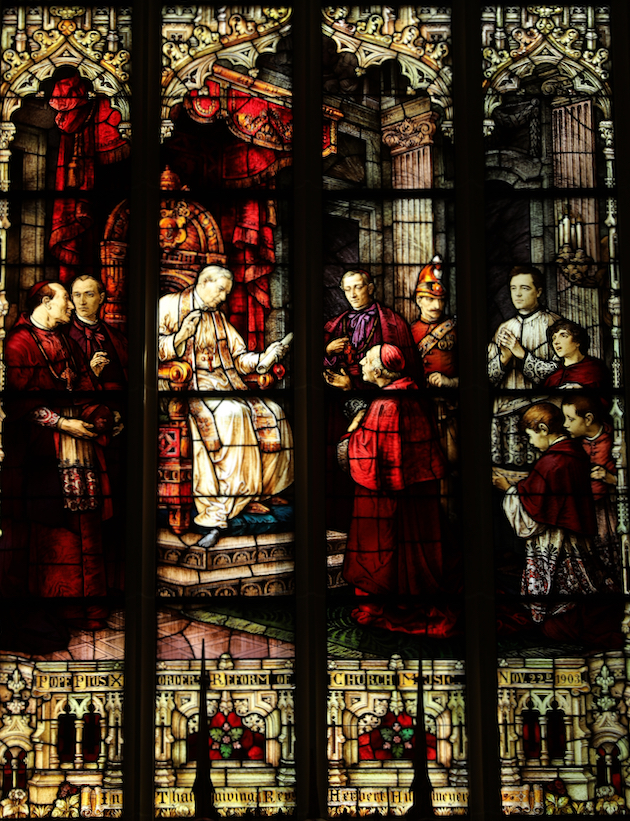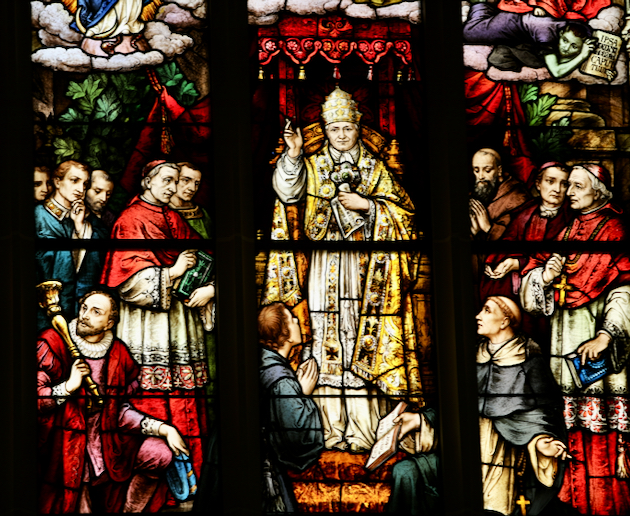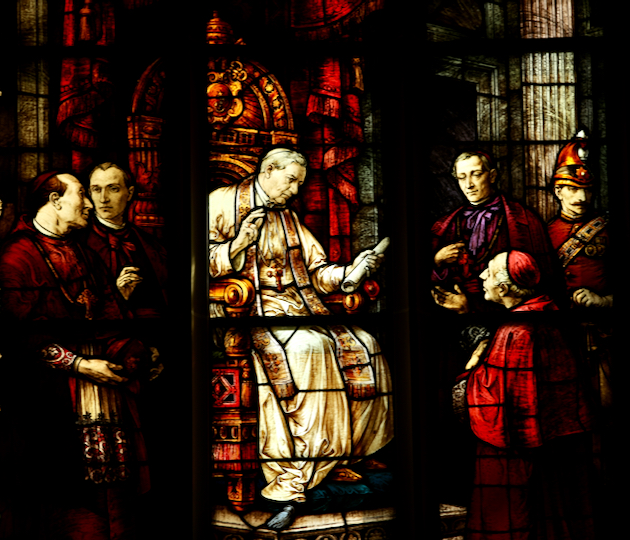
The actions of present Pope have put incredible stress on the Church’s constitution – the papal absolute monarchy. I’d like to offer some reflections on this system of government: ultramontanism. To understand it, though, we have to go back in history, starting with the reign of Pius IX when the ultramontanist regime received its “classic” form. I will focus on history – what actually happened – as opposed to theological considerations.
In the wake of the French Revolution the Church seemed to have collapsed when the pope died in French captivity in 1799. She survived – but never attained again the identification of the Catholic Faith with state, culture and society that had existed prior to 1789 in Catholic Christendom. The Church was henceforward a minority component of European society – even if one that remained enormously influential. The new mission was thus clear: the Church needed to re-evangelize Europe and the world – to rebuild the faith and her own institutions.
By the conclusion of the First Vatican Council in 1870 the face of the Catholic Church had indeed been renewed. What were the features of the new regime?
The Vatican Council of course was most famous for defining the infallible authority – under certain defined circumstances – of the Pope. But in practice (the “spirit of Vatican I”) the pope was henceforward treated as de facto infallible in all his decisions, at least in the sense in that no Catholic could question them. Any kind of discussion, let alone criticism, of the Pope was strictly prohibited.
The Pope’s immediate jurisdiction was extended directly to the entire world. All authority in matters of the faith, organization and liturgy was centralized in the Vatican. It was expected that normally the pope should have sole right to appoint bishops. Obedience to ecclesiastical authority was elevated to a central position in the Catholic faith. The Church’s independence from secular authority at every level was likewise proclaimed. Obviously, ultramontanism required adjustments to previously existing structures within the Church that had other organizational principles. For example, Leo XIII established in 1893 a Benedictine Confederation under an Abbot Primate, headquartered in Rome, that embraced the previously autonomous Benedictine congregations.
Going beyond these rules of governance, the pope assumed the position of chief spiritual leader and teacher of the Catholic Church. His image and personality were made known to Catholics throughout the world. It was expected that devotion would be paid to him.
Bishop Josip Juraj Strossmeyer (one of the opponents of ultramontanism at Vatican I) summarized the effects of Vatican I:
I went in a bishop and came out a sacristan.
The ultramontane regime was a reaction to the historic Gallicanism of the French Church and to the recent clashes over state interventions in the governance of the Church (e.g., in Prussia, Spain and Russia). To this was added the perceived weakness of national hierarchies and individual bishops in confronting secular governments. Loyalty to the Pope was cemented by the fierce anti-papal focus of most of the avowed adversaries of the Church – and their subjection to the powers of this world. For example, much of the opposition to Pius IX was clearly dependent on support from Prussia(a predominantly Protestant state!), on the German secular universities, etc.
But other developments which, at first glance, might have seemed hostile to the Catholic Church, encouraged ultramontanism as well. For example, the French Revolution and its successor, 19th century liberalism, had overthrown or drastically weakened rival regimes, such as the French monarchy, that previously had claimed a role in the government of the Church. It had expropriated or destroyed vested clerical institutions across Europe. By default, the papacy stood alone. Of course, in the days of Pius IX the Church rejected such theories ( like Cavour’s “free Church in a free state”). Do we not also detect in ultramontanism the influence of another 19th century development: the Napoleonic regimes? Under Napoleons I and III all power in France had been concentrated in one absolute, charismatic leader – originally, as a bulwark against revolutionary excesses.
Now ultramontanism was not achieved in a day. The system took many decades to perfect. Did not the Austrian emperor’s veto of cardinal Rampolla’s candidacy for the papacy – an extreme un-ultramontane action– take place as late as 1903? The Pope himself was still surrounded and framed by the elaborate ritual trappings of the past: the noble guards, the fans, the sedia gestatoria. For the first 60 years after the Vatican council the Pope remined a “prisoner of the Vatican.”
Yet, as the years went on, the ultramontane elements of Catholicism increased. The last state in Europe that could be considered to be remotely a Catholic monarchy, the Austro-Hungarian empire, dissolved in 1918. In 1929 a new peace agreement was signed with Italy, giving the Holy See once more possibilities of freedom and independence. And as formerly mission territories such as the United States grew in importance the ultramontane element of the Church also increased. Developments in technology and communications (such as radio) also assisted in spreading the message of the Vatican and the Pope throughout the Catholic world and beyond.
Between 1846 and 1958, the Church accomplished many great things. First and foremost she did not disintegrate under the hammer blows of liberalism in the second half of the 19th century and she survived the far more violent attacks of anticlerical, communist and national socialist regimes in the first half of the 20th century. Aided by the spread of European colonial regimes, the Catholic Church now became truly universal. Did not the United States, a former colony, advance between 1840 and 1960 from the status of an outlying mission territory to one of the strongest and wealthiest national churches in the world? Analogous progress occurred throughout the then vast British empire. Innumerable new congregations and orders sprang up, mostly devoted to an active apostolate of some kind: education, health care, the missions, etc. In the Catholic world entire nations sought a new, closer link between Church and state (Ireland, Spain and Portugal)
By the reign of Pius XII a new level of respect also seemed to have been achieved at least in that part of the world dominated by the United States and its allies. Catholic politicians were playing a key role in many of the nations on the continent of Europe. In the United States itself, a new era of harmony with the non-Catholic world seemed to have been established. Concrete evidence of this is the vast number of churches and schools that were built in the 20 years after the end of the Second World War. Did this not demonstrate the great success of the Church – as reformed under Pius IX?
And the successes of the Church were not merely material or measured by numbers. New devotions such as Lourdes and Fatima, new saints such as St. Theresa of Lisieux exercised a worldwide influence. A whole new galaxy of apologists testified to their Catholic faith, often using the literary forms of the novel or poetry. Many individual artists (e.g., Gaudi, Bruckner) devoted their efforts to the Catholic Church. Furthermore, the Church rediscovered its treasures of chant and of medieval philosophy. She developed Catholic positions in regard to the totally new economic situation that had arisen in the course of the 19th century. Finally, the 20th century produced legions of new martyrs – in Mexico, Spain, the Soviet Union, after World War II throughout Eastern Europe and, during this entire era, across the colonial/ developing world ( e.g., China).

The Cathedral of Covington contains an unusual series of windows illustrating dogmatic and administrative decrees of popes and councils. They are evidence of the central role that the pope and the Vatican had assumed in Catholic culture by 1914. (Above) The proclamation of the doctrine of the Immaculate Conception by Pius IX; (below) a detail of the window showing Pius X issuing his decree on church music.

But there was another side of the coin. Despite all the successes and the relentless whirlwind of activity there was a palpable narrowing of the Church after Vatican I. The Church seemed to have less and less relevance to the secular world, to be more and more remote and turned in on itself. The great hopes in the immediately preceding period of a grand Catholic recovery and of the reconversion of Europe – such as those of the Oxford movement, led by Newman, or of German Romanticism culminating in the regime of King Louis I of Bavaria – had evaporated. A great uniformity of belief and practice was achieved – among the believers. But if we expanded the definition of the Church to include the entire baptized population, the results in key Catholic countries were less impressive. Didn’t communists play a tremendous political role in France and Italy post-1945? And the cultural influence – even dominance – of these Stalinist parties in those years was even more impressive.
Perceptive observers noted problems early on in the seemingly solid framework of ultramontane culture. For example, Joris-Karl Huysmans asked why most of the prominent Catholic apologists of his age were converts – not the products of the Catholic educational system. He saw the ugliness of much of the art and architecture of the Church of that time as a truly satanic influence. Huysmans also had reservations about the products of Catholic seminaries in France, and early on spotlighted certain abuses that would become all too obvious towards the end of the 20th century.
These “spiritual” and “cultural” deficiencies seemed to increase as time went on even though ever greater material resources became available. As evidence, compare the 1950s edition of the Catholic Encyclopedia in the US with its predecessor of 1907-13, or the Basilica of the Immaculate Conception in Washington with the 1918 church of Saint Vincent Ferrer in New York City. That eminent university president Robert Maynard Hutchins (who had enabled the teaching of neo-scholastic philosophy at the University of Chicago) is reported to have frankly told the assembled presidents of the Catholic colleges of the United States what a mediocre job they were doing. And, as we know now, many individuals of doubtful faith or morality – and sometimes both – entered the priesthood and the religious life in the last great wave of expansion after the Second World War.
Aside from its spiritual problems, ultramontanism entailed a number of practical difficulties. By centralizing all authority in the Pope the entire Catholic Church now became involved in the issues of any one particular church. Grand, centrally directed papal initiatives such as the reform of Church music under Pius X also created very negative side effects – attributable in part to the difficulty of attempting detailed management of local affairs from the Vatican. The very nature of the ultramontanist regime tended to advance the careers of bureaucrats, builders and administrators rather than spiritual leaders among the bishops.
The claims of papal authority created expectations that could never be fulfilled. There was disappointment – unspoken or not – at the Ralliement under Leo XIII, the reaction of the Church to the French secularization decrees in 1905, the papal disavowal of Action Francaise, the Vatican’s management in Germany of the relations of the Catholic Church and the Catholic political party with the Nazi regime, among other actions. Sometimes this criticism came from the left and sometimes from the right. But a common thread was the expectation that in the 20th century the Church needed to make heroic gestures in opposition to the forces of the world. The cautious and perhaps prudent reserve of the Vatican seemed to contrast with its grand claims of omnipotence.
Characteristic of the last years of ultramontanism under Pius XII was a circa-1960 study that compared the management structure of the Catholic Church with an American business corporation – General Electric, I believe. The comparison, according to most reports I have seen, was favorable to the Church. Yet in this analysis, the Church explicitly assumes the role of a minority participant in the ruling secular “civil society” of the West. Similarly, around the same time the popular Catholic historian Henri Daniel-Rops affected to discern, from the perspective of ultramontanism, a positive side even to events like the separation of Church and State in France in 1905:
(I)t marked the end of Gallican tendencies, which was a notable contribution towards Pius X’s effort to strengthen the hierarchy and centralize ecclesiastical government. Henceforward there would be no intermediary between the pope on the one hand and the clergy and Christian people of France on the other. The bishops would be chosen directly by Rome….1)
Late ultramontanism thus was now reaching political conclusions almost the opposite of those of Pius IX.
By 1930, at the latest, there was also a revival of progressive Catholicism. As always, leftism proceeds from the existence of very real problems and issues. There was a real sense that it was inadequate for the Church to remain a society within a society, separate from the world. What was necessary was the reconversion of the entire world to Christianity. But almost from the beginning less wholesome views mingled with these aspirations. What started as frustration with the timid “bourgeois” nature of ultramontanist Catholic witness and the Church’s excessive conformity to this world, developed into at first admiration and then uncritical acceptance of 20th century secular regimes. Initially there was undisguised jealousy of the alleged successes of totalitarian movements, especially communism, in inspiring their followers and in “solving the problems” of modern man. Dorothy Day is a case study in this. Later, of course, with Jacques Maritain, the focus of these feelings of Catholic inferiority switched to the United States and the democratic society.
During the reign of Pius XII a pervasive culture of internal criticism emerged within the Church. Given the restrictions on Catholic discourse, it often took the disguised form of historical, liturgical, philosophical, or artistic studies. By 1959 all aspects of Catholic tradition were routinely depicted as corrupt and purely arbitrary products of historical circumstance. It seemed the entire Church had taken the wrong direction even as early as the 4th century (the famous “Constantinian” transformation). A truly revolutionary situation was emerging, at least within the Western European churches, when Pope John XXIII succeeded to the papacy. And the actors in this budding revolution weren’t representatives from the fringes, but the official intellectuals and clerical bureaucrats of the Catholic Church herself. It was a revolution from above, by the establishment, that was in the making. The regime of ultramontanism at the Vatican itself seemed completely incapable of discerning what was going on even among its own proteges.
- Daniel-Rops, Henri, A Fight for God 1870-1939 Vol I at 221( John Warrington, transl.)( Image Books, Doubleday & Company, Garden City, 1967)
Related Articles
No user responded in this post